During World War II, a bomb shelter was built in the garden of a farmhouse in Norfolk, England. After the war, its entrances were blocked and the mound of earth covering it was planted with shrubs and trees, hiding it from view. We follow the excavation of its entrances and take you inside to see a room hidden from human eyes for many decades.
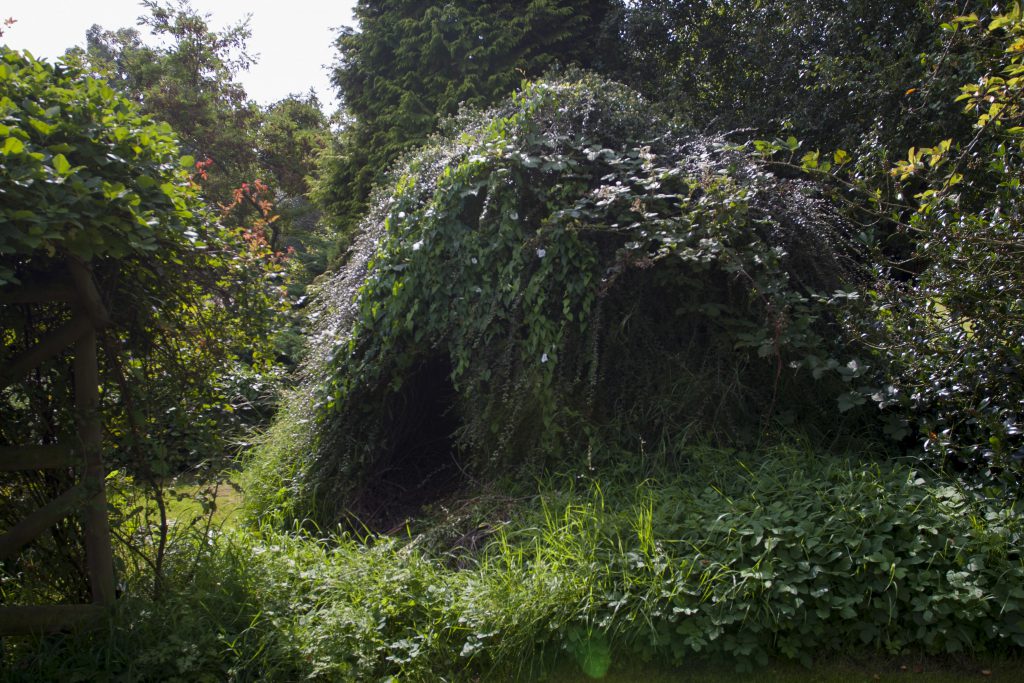
This large bush totally hid the entrance to the shelter
In the summer of 2011 I visited a friend who was living in a large farmhouse owned by her family. She showed me around the garden and commented that a large grassy mound covered with conifers, shrubs and plants, contained a second-world-war bomb shelter. The farmhouse was far from any factory or town which might have been a target for the Luftwaffe, so the reason for the bomb shelter’s construction was unclear, however, German officers were held at the farmhouse during the war, so the shelter probably had something to do with the farm’s military occupation.
As soon as I knew the shelter was there, I became curious about it and wanted to know where the entrance was, for it was impossible to see. I was told that there was a door hidden somewhere under a huge bush that measured 10 feet across and several meters high. My friend had a recollection of seeing a door there when she was a child, but she had never seen inside. In fact, only the father of the family had been inside the shelter and his single exploration had taken place 40 years earlier.
I asked the family if they would allow me uncover the door so that I could investigate the shelter and they agreed on the condition that I didn’t make too much of a mess. A few weeks later I returned with some clippers and shovels, and asked again under which bush the entrance was most likely to be found.
The target bush was incredibly dense and more than a meter deep, so I began clipping a hole on one side, roughly where I thought the door was located. Once the new outer growth was removed, I discovered that the underlying branches were mostly dead and brittle and broke away relatively easily. I smashed and cut a tunnel five feet deep until I could make out a brick door frame and a painted wooden door. Only about three feet of the door was visible above the soil level, so I assumed that another three feet of it was below ground.
At this point I was coming to the door from the side, so I abandoned the tunnel and started another one further round the bush. The new tunnel was directly in front of the door.
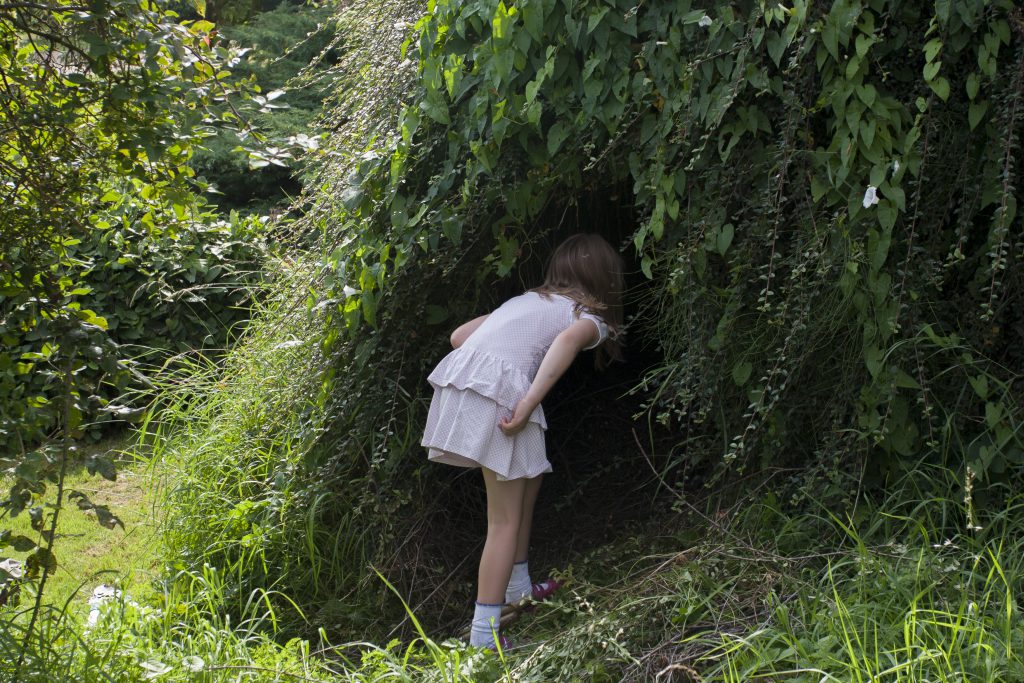
A young investigator takes a look inside…
An hour or so later, the new tunnel was cut all the way up to the door. I found the wood to be extremely rotten and there were several holes in it, but the void beyond was too dark for me to see what was inside, So my next task was to dig away the pile of soil so that the door could open. I soon discovered that large blocks of concrete and brick had been buried in the soil, so first of all I dug these out along with a stubborn old tree stump.
I was expecting to have to dig quite deep into the ground to unearth the rest of the door, however, to my surprise, I found that the bottom was only about 18 inches below the soil, meaning that the height of the door was only about four foot. The lower ends of the vertical planks had completely rotted away, so as I dug away I could hear clumps of earth tumbling down inside the hole beyond.

The first view of the door from the new tunnel
It sounded as if there was quite a drop below, which also came as a surprise to me given my previous experience of bomb shelter design. Near where I had lived as a child there was a second-world-war airfield, peppered with bomb shelters, which us local children explored regularly. These shelters were semi-circular concrete structures not entirely dissimilar in shape to some of the old linking tunnels in the London underground. The shelters were constructed out of pre-cast sections that were bolted together at the top and along each edge. On top at one end was a chimney/ventilation shaft almost large enough for an adult to climb through. Then a single entrance was set in the wall at the opposite end to the chimney. A few feet in front of the doorway stood a large brick wall, clearly designed to protect the door from a bomb blast.
Most of the shelters were only slightly below ground level and had no more than a few steps leading into them. Some had been covered with earth to protect and disguise them from the air, and many had shrubs growing on top making them even less conspicuous. Nevertheless, their simple shape made it easy to tell from the outside how they were configured on the inside.
The bomb shelter I was attempting to excavate was already looking like a very different design to those I was used to exploring. Not only was the door extremely small, but there was a sizeable drop on the other side of it. I could find no chimney and if there had ever been a blast wall in front of the door it was long gone. Most significantly of all, the doorway seemed to be at 90 degrees to the length of the shelter, and not set in the end wall.
After another hour of digging I had cut a level path through the compacted earth all the way up to the entrance and I was able to remove the door completely. The hole that faced me was extremely dark, but I could immediately tell that the shelter had been built entirely below ground level, meaning that the dome of earth on top was not in fact shaped by the shelter’s roof, but was piled in that way to protect the roof of the shelter and its protruding door aperture, the top of which sloped steeply down into the mound from about five feet above ground level.
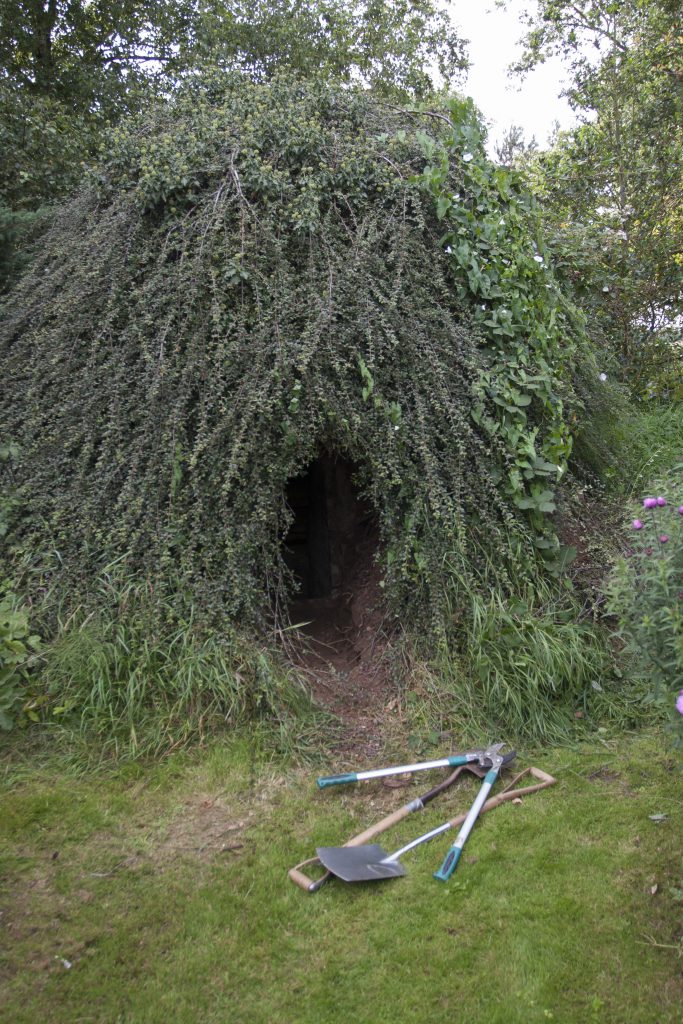
At last the soil was cleared away down to the bottom of the door, and the door itself was removed
I used the flash on my camera to reveal what was hidden by the darkness. At the bottom immediately below the door there was a large pile of rubble sloping down into a very narrow corridor. I couldn’t tell how much of a drop there was so I found an adjustable stepladder in a shed and lowered it down. As it turned out, the rubble was a little over six feet down directly below the entrance, but then sloped away into the tunnel.

This picture shows the stepped roof of the entrance

Down, down!
I estimated that the corridor was 10 feet long, taking it roughly halfway across the width of the mound. At the end it turned 90 degrees to the left.
It was unnerving not being able to see what might be around the corner, but the only way to find out was to be brave and climb down into the dark.
Armed with a torch, I descended the ladder into the darkness. It immediately struck me how tight the entrance really was. For a start, the roof stepped downwards at a very steep angle, meaning that there was absolutely no room for stairs. Only the almost-vertical ladder made it possible to get inside. Secondly, the walls were barely shoulder width apart, which made it feel very claustrophobic.
When I reached the bottom of the ladder I noticed that the wall immediately below the door dropped three feet to a soil-covered brick shelf. It was only a brick’s width, but I noted that it would enable a nimble person to climb out without the use of a ladder. Below the shelf the wall fell another three or four feet to meet the soil that had spilled down onto the pile of rubble, and this in turn sloped down another few feet further along the passage.
As I walked further in I could see that the lower portion of the inner walls had originally been rendered with concrete, but the damp conditions had meant that much of the render had peeled away and now formed broken slabs on the floor. There were also fragments of bricks, plant debris, and broken glass bottles under foot. As I moved further in I could see more clearly the small doorway that turned to the left at the end of the narrow corridor. At this point the roof and floor had levelled out but there was only about for feed of head height so I was having to crouch right down as I walked.

The end of the first corridor. Here we can see the passage going off to the left. It’s roof is even lower!
When I reached the end wall and turned left I was faced with a pitch-black opening. I’d expected to see a large semi-circular room arching up to a height of about six feet, just like the bomb shelters I had explored as a child, but this design was very different.
In front of me was another very low and narrow brick corridor extending into the dark. My torch beam revealed to me that somewhere along the corridor, it opened up on both sides, but beyond the inner space was another section of corridor much like the bit immediately in front of me. I could not tell where that section went, but speculated that it might lead to another room.

The view after turning the first corner
Throughout the corridor there seemed to be a lot of debris. Apart from the half-inch slabs of fractured cement render that had fallen from the walls, there were bottles, brick fragments and rusted tins and barrels, all lying about the floor. I’d been expecting to find it flooded, just like the cellar of the farmhouse, but it was surprisingly dry. I was also worried that I might disturb a terrifying flock of bats, a nest of snakes or family of rats. I was only wearing sandals and shorts, and had barely enough room to turn around, let alone escape at speed.
The rusty barrels started giving me other concerns. I wondered if they contained chemicals which these days would be banned for health and safety reason. I also worried that their might have been asbestos used in the shelter’s construction, and that carbon monoxide might have accumulated in the confined space.
I decided to progress slowly, keeping an eye out for rats and anything that looked like asbestos, and to get out immediately if I started feeling dizzy.
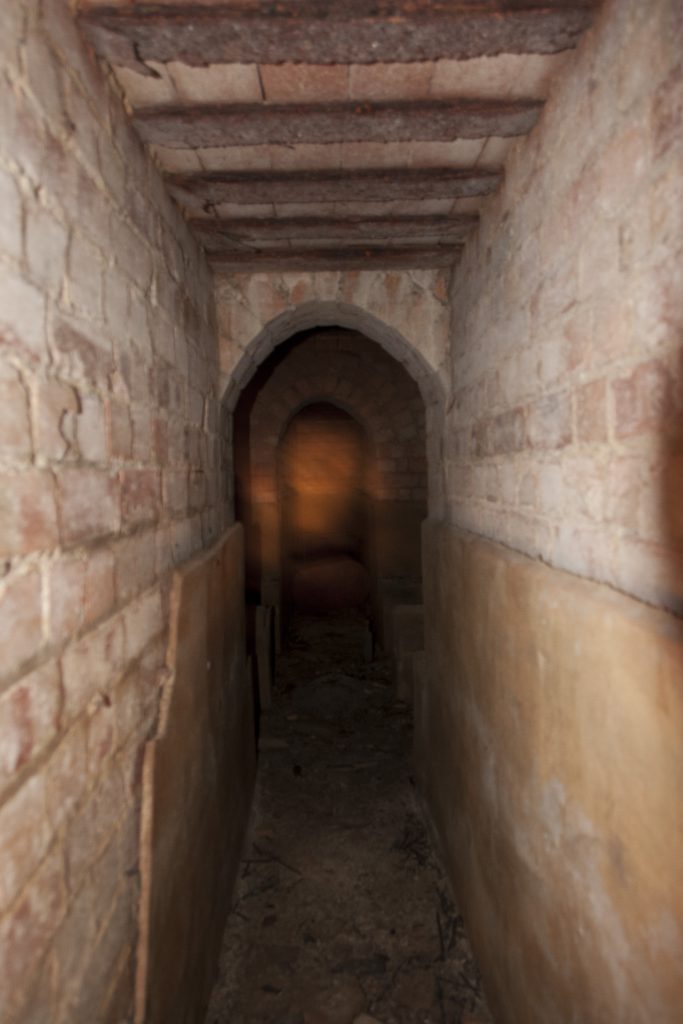
The structure of the ceiling is clearly visible here
I crouched down and shuffled through the next section of four-foot-high corridor, until I reached the inner space, but was surprised to find that it was only long enough for a few people to squeeze in alongside one another (given the size of the mound I’d been expecting there to be a large area capable of housing a medium-sized family for the night). On both sides of the room stood three small brick walls which must have once held wooden shelves on which several people could sit. I measured the room as being just under seven feet in length, but the recesses were no more than 15 inches deep each side of the corridor. This meant that they were long enough for beds, but not nearly deep enough.
At this stage I started to wonder why there were so many slabs of render laying about the place. I concluded that the ceiling had originally been rendered and that the slabs under foot had fallen down under the pressure of groundwater. It was interesting to see that, rather than using an arch structure for the roof of the corridors, strips of steel acted as roof beams. The beams were positioned so close together that bricks could be laid flat on top, and so the only vaulting that the builders had deemed necessary was above the doorways.
In the middle of the ceiling of the room I could see an air hole and immediately below it on the floor was a small pile of grit which had slid down the tube. The tube itself had become thoroughly blocked with debris so if the shelter were to be made safe for people to look around the blockage would need to be cleared.

The inner sanctum!

The spaces either side of the corridor are only 15 inches wide!

And the path ahead…
I passed through the centre area and on into the next low corridor, stepping over some rusted canisters along the way. This was the most scary part of the investigation because I was heading towards some kind of dead end and it was a long way from where I had entered the shelter.
At the furthest point the corridor turned 90 degrees back to the left. When I turned the corner I was faced with yet another stretch of narrow, low corridor, littered with yet more rusted canisters and glass bottles. I had hoped that it would open into a larger chamber but the corridor simply ended with another 90 degree turn, this time to the right.
This was where the investigation ended, for the route was blocked by a huge pile of junk and rubble. It appeared as though a deliberate attempt had been made to block the passage and it did not look like the sort of thing that was easy or safe to remove from inside the dark, airless corridor.
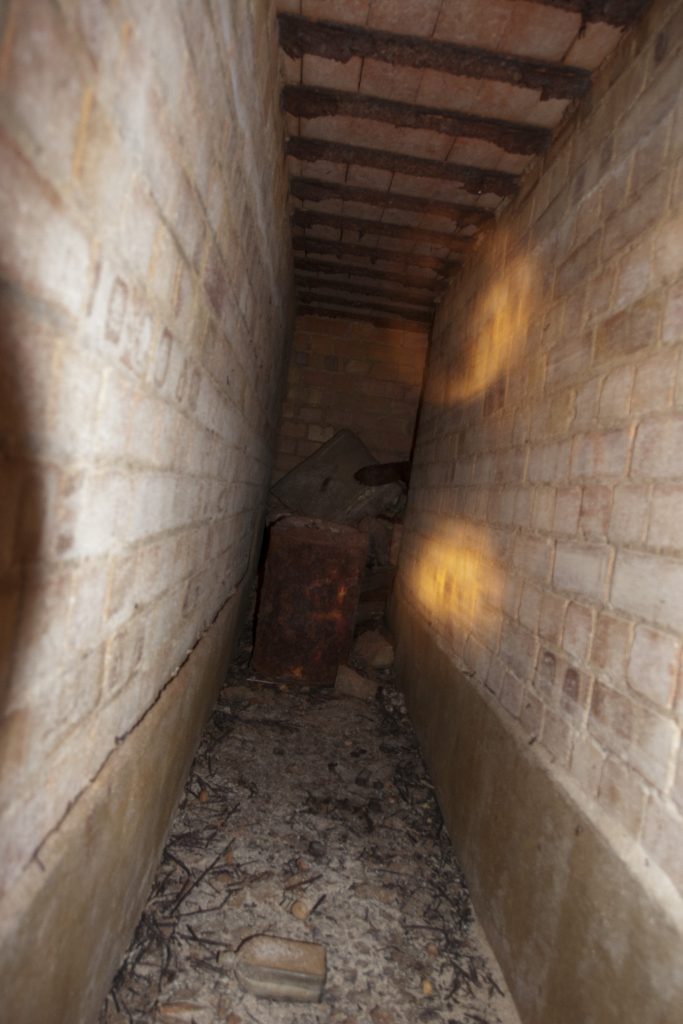
There was a 90 degree turn to the left at the end of the central corridor, and this is what was around the corner… another corridor! It turns right at the end, but that passage is blocked
I went back out and returned with my six-year-old, who was very keen to take a look inside and help me take photos. She shone her torch on the walls and I used the spot of light to focus the camera and take some flash-enabled shots.
When we were done and I tried putting the rotten door back in place, I realised that it was not solid enough to prevent children from falling down the hole, so I quickly found some materials and tools in the farm outbuildings, constructed a tight-fitting wooden frame and covered it with chicken wire.
Another reason for making the door was that in the shelter I had found a skeleton which looked as though it might be that of a cat, although in retrospect I think it was from a large rat. Whatever the case, I did not want one of the farm’s pets getting stuck down there, so I constructed the frame so that it would prevent anything of that size getting in.
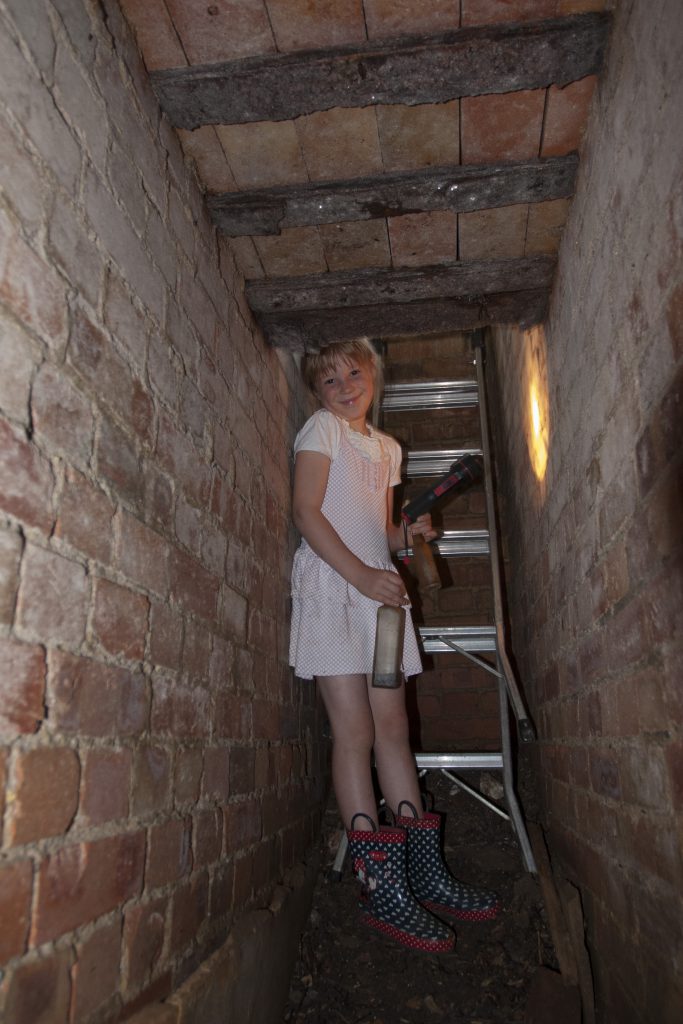
If you are wondering how tight the corridors are, here is a six-year-old to provide scale

My assistant holds the torch so that the camera can see something to focus on. The picture looks bright with the flash, but in reality no light gets this far into the shelter!

Inside the shelter
Once I’d had time to ponder what I had seen, it struck me that the blocked tunnel at the other end must have been another way in. I thought some more and realized that it was not just another way in, but the main way in and there was probably a flight of steps leading down from the surface. The door I had uncovered was more than likely just an emergency exit for use if something happened to block the main entrance. It was the equivalent of the chimney I had seen on other bomb shelters. My theory explained why there was just a large drop and no proper stairway behind the door.
Face with the realization that somewhere in the mound of earth and shrubs was a set of stairs leading down into the shelter, I was filled with the urge to find it and clear out the blockage. If it could be done from above ground then there would be no danger of suffocating in toxic gasses, having everything tumble down upon me, or coming across something nasty and not being able to get out of its way! I asked the owners if they would mind me doing some more digging, and they agreed to let me excavate further.

On the way out
I then began working out the best way to pinpoint the spot or area where the entrance was buried. There was, of course, no way to know the angle of the stairs or the length of the corridor they occupied without unblocking it first, so it was more a case of narrowing down the general area of the entrance than finding its exact position. I also planned to make a search for the air pipe and see if it was something that could be cleared out.
I was aware that piling the soil off to one side of the flower bed (as I had done before), would not be possible. There would be too much of it, plus I would have to dispose of the large rusty cans and concrete blocks that had been used to pack out the stair corridor. I could see that I’d have to take the rubble to a far off area of the farm in a wheelbarrow and realised that stage two of the project was going to be much more work than stage one.
Part 2 of the Bomb Shelter Excavation Project can be found here: Part 2







